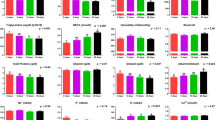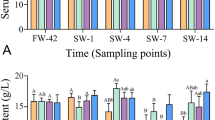Abstract
In order to estimate the mobilization of nitrogen compounds for energetic purposes in trout under hypoxic conditions, commercial-size rainbow trout, acclimated to 15°C, were maintained for 10 weeks at an oxygen level of 5.3 ± 0.5 mg/l (‘hypoxic’ group) or 8.4 ± 0.4 mg/I (control group), and the changes in tissue concentrations of free amino acids and proteins studied. In animals subjected to hypoxia, there was a decrease in plasma free amino acids involved in gluconeogenesis, liver alanine and aspartic acid, plasma and liver protein concentrations, and muscle free histidine. These results suggest a trend of rainbow trout metabolic activity towards energy production at the expense of anabolism when oxygen availability in water is limited over a long period of time.
Similar content being viewed by others
References cited
Abe, H., Dobson, G.P., Hoeger, U. and Parkhouse, W.S. 1985. Role of histidine related compounds to intracellular buffering in fish skeletal muscle. Am. J. Physiol. 249: 449–454.
Bahamondes-Rojas, I. 1982. Influence de la témperature et du taux d'oxygène dissous sur la nutrition azotée de la truite arcen-ciel (Salmo gairdneri Rich.). Etude de l'évolution postprandiale des acides aminés libres. Etude de la proteosynthèse. Thèse Doct. Spé. INP Toulouse.
Bouck, G.R. 1972. Effects of diurnal hypoxia on electrophoretic protein fractions and other health parameters of rock bass (Amploplites rupestris). Trans. Am. Fish. Soc. 101: 486–493.
Burton, D.T. and Spehar, A.M. 1971. Reevaluation of the anaerobic end products of fresh water fish exposed to environmental hypoxia. Comp. Biochem. Physiol. 40A: 945–954.
Cornish, E.C., Cussen, C.M., Hird, F.J.R. and Todd, P.E.E. 1978. Comparative aspects of aminotransferases in the rat, pigeon and rainbow trout. Comp. Biochem. Physiol. 61B: 375–378.
Davis, J.C. 1975. Minimal dissolved oxygen requirements of aquatic life with emphasis on Canadian species: a review. J. Fish. Res. Board Can. 32: 2295–2332.
Demael-Suard, A., Garin, D., Brichon, G., Mure, M. and Peres, G. 1974. Neoglucogénèse à partir de la glycine 14C de la tanche (Tinca vulgaris) au tours de l'asphyxie. Comp. Biochem. Physiol. 47A: 1023–1033.
Driedzic, W.R. and Hochachka, P.W. 1975. The unanswered question of high anaerobic capabilities of carp white muscle. Can. J. Zool. 53: 706–712.
Driedzic, W.R. and Hochachka, P.W. 1978. Metabolism in fish during exercise.In Fish Physiology, Vol. 7, Locomotion. pp. 503–543. Edited by W.S. Hoar and D.J. Randall. Academic Press, New York.
Johnston, I.A. 1975 a. Studies on the swimming musculature of the rainbow trout. II. Muscle metabolism during severe hypoxia. J. Fish Biol. 7: 459–467.
Johnston, I.A. 1975 b. Anaerobic metabolism in the carp (Carassius auratus L.). Comp. Biochem. Physiol. 51B: 235–241.
Kutty, M.N. 1972. Respiratory quotient and ammonia excretion inTilapia mossambica. Mar. Biol. 16: 126–133.
Lowry, O.H., Rosebrough, N.J., Farr, A.L. and Randall, R.J. 1951. Protein measurement with the Folin phenol reagent. J. Biol. Chem. 193: 265–275.
Luquet P. and Kaushik S.J. 1981 Besoins en proteines et en acides aminésIn Nutrition des poissons. pp. 171–174. Edited by M. Fontaine CNRS, Paris.
Medale, F., Parent, J.P. and Vellas, F. 1985. Effet d'une réduction de l'oxygénation de l'eau sur l'excrétion d'ammoniaque chez la truite arc-en-ciel (Salmo gairdneri Rich.). Rev. Fr. Sci. Eau 4: 341–347.
Meister, A. 1957. Biochemistry of the amino acids. Academic Press, New York.
Peer, M.M. and Kutty, M.N. 1981. Respiratory quotient and ammonia quotient inTilapia mossambica (Peters) with special reference to hypoxia and recovery. Hydrobiologia 76: 3–9.
Randall, D.J. 1982. The control of respiration and circulation in fish during exercise and hypoxia. J. Exp. Biol. 100: 275–288.
Smith, M.J. and Heath, A.G. 1980. Responses to acute anoxia and prolonged hypoxia by rainbow trout (Salmo gairdneri) and mirror carp (Cyprinus carpio) red and white muscle: use of conventional and modified metabolic pathways. Comp. Biochem. Physiol. 66B: 267–272.
Vellas, F. and Parent, J.P. 1983. Le catabolisme des acides aminés chez les poissons. Ichtyophysiol. Acta 7: 76–88.
Walton, M.J. and Cowey, C.B. 1982. Aspects of intermediary metabolism in Salmonid fish. Comp. Biochem. Physiol. 73B: 59–79.
Author information
Authors and Affiliations
Rights and permissions
About this article
Cite this article
Medale, F., Parent, J.P. & Vellas, F. Responses to prolonged hypoxia by rainbow trout (Salmo gairdneri) I. Free amino acids and proteins in plasma, liver and white muscle. Fish Physiol Biochem 3, 183–189 (1987). https://doi.org/10.1007/BF02180279
Issue Date:
DOI: https://doi.org/10.1007/BF02180279




